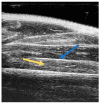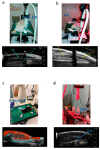Preclinical Ultrasonography in Rodent Models of Neuromuscular Disorders: The State of the Art for Diagnostic and Therapeutic Applications
- PMID: 36902405
- PMCID: PMC10003358
- DOI: 10.3390/ijms24054976
Preclinical Ultrasonography in Rodent Models of Neuromuscular Disorders: The State of the Art for Diagnostic and Therapeutic Applications
Abstract
Ultrasonography is a safe, non-invasive imaging technique used in several fields of medicine, offering the possibility to longitudinally monitor disease progression and treatment efficacy over time. This is particularly useful when a close follow-up is required, or in patients with pacemakers (not suitable for magnetic resonance imaging). By virtue of these advantages, ultrasonography is commonly used to detect multiple skeletal muscle structural and functional parameters in sports medicine, as well as in neuromuscular disorders, e.g., myotonic dystrophy and Duchenne muscular dystrophy (DMD). The recent development of high-resolution ultrasound devices allowed the use of this technique in preclinical settings, particularly for echocardiographic assessments that make use of specific guidelines, currently lacking for skeletal muscle measurements. In this review, we describe the state of the art for ultrasound skeletal muscle applications in preclinical studies conducted in small rodents, aiming to provide the scientific community with necessary information to support an independent validation of these procedures for the achievement of standard protocols and reference values useful in translational research on neuromuscular disorders.
Keywords: neuromuscular disorders; skeletal muscle; translational research; ultrasonography.
Conflict of interest statement
The authors declare no conflict of interest.
Figures



Similar articles
-
Muscle ultrasound in neuromuscular disorders.Muscle Nerve. 2008 Jun;37(6):679-93. doi: 10.1002/mus.21015. Muscle Nerve. 2008. PMID: 18506712 Review.
-
Validation of ultrasonography for non-invasive assessment of diaphragm function in muscular dystrophy.J Physiol. 2016 Dec 15;594(24):7215-7227. doi: 10.1113/JP272707. Epub 2016 Oct 13. J Physiol. 2016. PMID: 27570057 Free PMC article.
-
Detecting degenerative changes in myotonic murine models of Duchenne muscular dystrophy using high-frequency ultrasound.J Ultrasound Med. 2010 Mar;29(3):367-75. doi: 10.7863/jum.2010.29.3.367. J Ultrasound Med. 2010. PMID: 20194933
-
Long-Term Protective Effect of Human Dystrophin Expressing Chimeric (DEC) Cell Therapy on Amelioration of Function of Cardiac, Respiratory and Skeletal Muscles in Duchenne Muscular Dystrophy.Stem Cell Rev Rep. 2022 Dec;18(8):2872-2892. doi: 10.1007/s12015-022-10384-2. Epub 2022 May 19. Stem Cell Rev Rep. 2022. PMID: 35590083 Free PMC article.
-
How useful is muscle ultrasound in the diagnostic workup of neuromuscular diseases?Curr Opin Neurol. 2018 Oct;31(5):568-574. doi: 10.1097/WCO.0000000000000589. Curr Opin Neurol. 2018. PMID: 30028736 Review.
Cited by
-
Ultrasound-based assessment of the expression of inflammatory markers in the rectus femoris muscle of rats.Exp Biol Med (Maywood). 2024 Feb 29;249:10064. doi: 10.3389/ebm.2024.10064. eCollection 2024. Exp Biol Med (Maywood). 2024. PMID: 38463389 Free PMC article.
References
-
- Ruaro B., Soldano S., Smith V., Paolino S., Contini P., Montagna P., Pizzorni C., Casabella A., Tardito S., Sulli A., et al. Correlation between circulating fibrocytes and dermal thickness in limited cutaneous systemic sclerosis patients: A pilot study. Rheumatol. Int. 2019;39:1369–1376. doi: 10.1007/s00296-019-04315-7. - DOI - PubMed
Publication types
MeSH terms
Grants and funding
LinkOut - more resources
Full Text Sources
Medical

